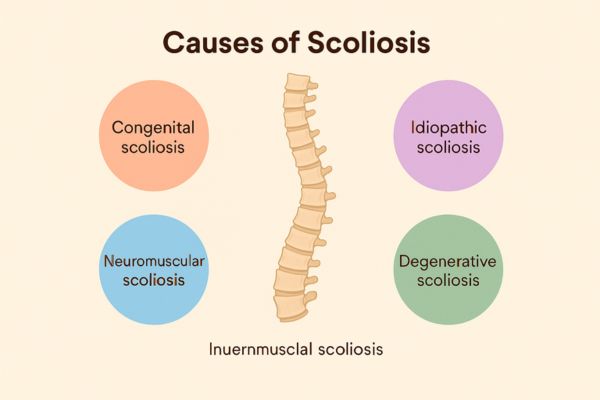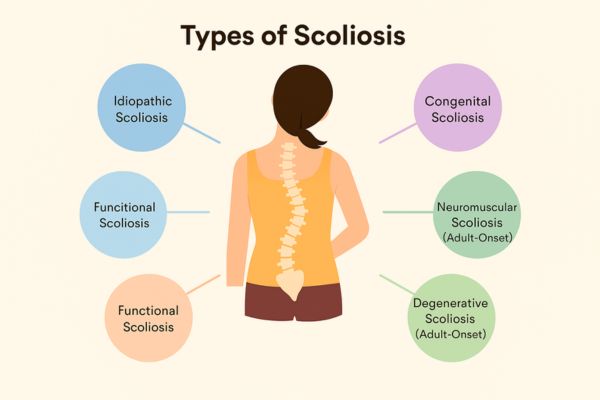Scoliosis Treatment in Mumbai by Dr. Vishal Kundnani

What Is Scoliosis?
Scoliosis treatment in Mumbai by Dr. Vishal Kundnani, a renowned scoliosis surgeon, focuses on correcting the abnormal sideways scoliosis surgeon, focuses on correcting the abnormal sideways curvature of the spine, known as scoliosis. In a healthy spine, the vertical alignment appears straight when viewed from the front or back and displays a natural roundness in the upper back along with a gentle inward curve (swayback) in the lower back when seen from the side. However, in individuals with scoliosis, the spine curves laterally, forming a noticeable "S" or "C" shape when viewed from the front or back.
As a leading scoliosis surgeon in Mumbai, Dr. Vishal Kundnani specializes in advanced techniques for scoliosis surgery, delivering expert correction for complex spinal deformities. Patients seeking comprehensive evaluation and effective scoliosis surgery can rely on his expertise and commitment to restoring spinal alignment and function.
What Causes Scoliosis?
There are many types and causes of scoliosis, including :

Congenital scoliosis - Caused by a bone abnormality present at birth.
Neuromuscular scoliosis - A result of abnormal muscles or nerves. Frequently seen in people with spina bifida or cerebral palsy or in those with various conditions that are accompanied by, or result in, paralysis.
Degenerative scoliosis - This may result from traumatic (from an injury or illness) bone collapse, previous major back surgery, or osteoporosis (thinning of the bones).
Idiopathic scoliosis - The most common type of scoliosis, idiopathic scoliosis, has no specific identifiable cause. There are many theories, but none have been found to be conclusive. There is, however, strong evidence that idiopathic scoliosis is inherited.
Who Gets Scoliosis?
Approximately 2% to 3% of Americans at age 16 are diagnosed with scoliosis. However, less than 0.1% have spinal curves measuring greater than 40 degrees — the threshold at which scoliosis surgery is typically considered. Girls are more likely to be affected than boys. Idiopathic scoliosis is most commonly observed during adolescence, particularly between the ages of 10 and 16. This condition often progresses during the "growth spurt" years but generally stabilizes in adulthood.
When scoliosis progresses to a severe stage, consulting a highly experienced scoliosis surgeon becomes essential. For those in need of advanced treatment and surgical intervention, patients are advised to seek expert care from a leading scoliosis surgeon like Dr. Vishal Kundnani, renowned for his expertise in scoliosis surgery and spinal deformity correction.
How Is Scoliosis Diagnosed?
Most scoliosis curves are initially detected on school screening exams, by a child's pediatrician or family doctor, or by a parent. Some clues that a child may have scoliosis include uneven shoulders, a prominent shoulder blade, uneven waist, or leaning to one side which may cause chronic back pain.
At our state-of-the-art spine surgery center in Mumbai, we offer comprehensive scoliosis treatment options including both conservative management and surgical correction when needed.
Types of Scoliosis
Scoliosis can be classified into several types based on its cause and age of onset:

Idiopathic Scoliosis
-
The most common type, especially among adolescents.
-
The cause is unknown (idiopathic), and it often appears during the growth spurt before puberty.
Congenital Scoliosis
-
Present at birth due to malformations in the spine during fetal development.
-
May progress as the child grows.
Neuromuscular Scoliosis
-
Caused by neurological or muscular conditions like cerebral palsy, muscular dystrophy, or spinal cord injury.
-
Often more severe and requires specialized care.
Degenerative Scoliosis (Adult-Onset)
-
Develops in older adults due to spine degeneration, arthritis, or osteoporosis.
-
Can cause significant pain and posture issues.
Functional Scoliosis
-
A temporary curve caused by muscle spasms, leg length discrepancy, or inflammation.
-
The spine itself is structurally normal.
Symptoms of Scoliosis
Symptoms vary depending on the type and severity of the curve:
-
The impact of scoliosis can range from barely noticeable to highly disabling, depending on how severe or progressive the spinal curve is.
-
Uneven shoulders or waist - A visible difference in shoulder or waist height can occur as the spine curves, creating an imbalance in posture.
-
One shoulder blade more prominent than the other - The curved spine can rotate the torso, pushing one shoulder blade outward and making it appear more raised or pronounced.
-
One hip higher than the other - The spinal curve can tilt the pelvis, causing an uneven hip alignment and sometimes affecting walking or balance.
-
Leaning to one side - The body may naturally tilt to one side due to the spinal imbalance, especially in moderate to severe cases.
-
Back pain or muscle fatigue - Uneven spinal alignment puts extra stress on back muscles, often leading to discomfort or fatigue after standing or sitting for long periods.
-
Limited range of motion - The curvature and stiffness in the spine can restrict movement, particularly in bending or twisting motions.
-
Rib hump when bending forward - When bending over, a noticeable hump may appear on one side of the back due to spine rotation and rib cage distortion.
-
In severe cases: difficulty breathing due to reduced lung space - Severe spinal curvature can compress the chest cavity, reducing lung capacity and making breathing harder.
Treatment Options for Scoliosis
Treatment depends on the patient's age, the degree of curvature, and the type of scoliosis:
Observation
-
For mild curves (<20°) with no symptoms, especially in growing children.
Bracing
-
Used in children or adolescents with moderate curves (20° to 40°) to prevent progression.
Physical Therapy
-
Improves posture, muscle strength, and flexibility.
-
Schroth Method is commonly used in scoliosis rehabilitation.
Surgical Treatment
-
Recommended for severe curves (>40°–50°) or when the condition worsens.
-
Spinal fusion surgery is most commonly performed to stabilize the spine.
Scoliosis Care in Mumbai
If you or a loved one is experiencing signs of scoliosis, consult a spine specialist for early diagnosis and personalized treatment. Dr. Vishal Kundnani, an expert in spinal deformity correction and scoliosis treatment in Mumbai, offers comprehensive care using advanced diagnostics and minimally invasive surgical techniques.

